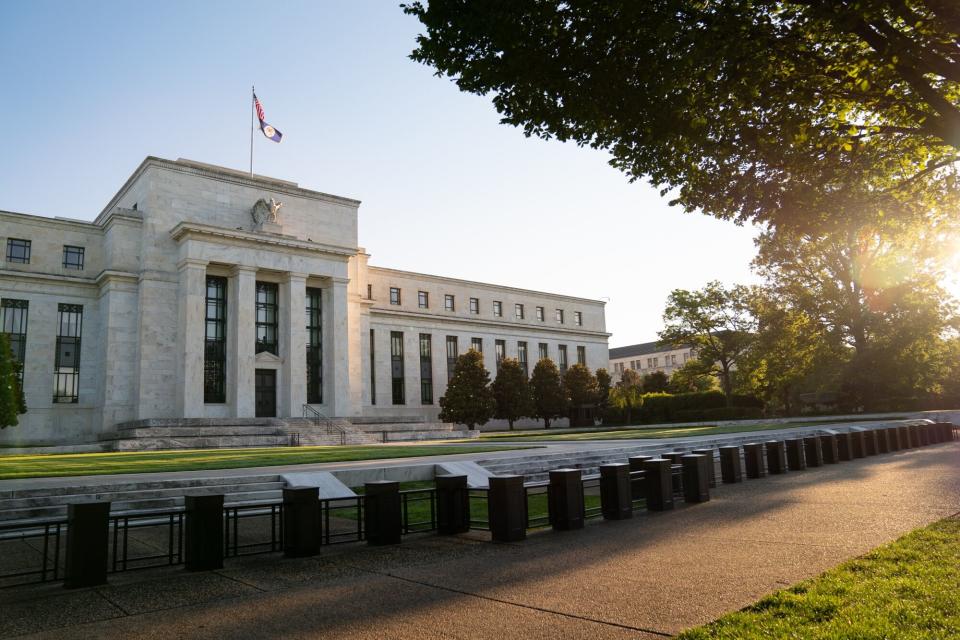Fed Minutes Show Several Saw Case for Cutting Rates in July

(Bloomberg) -- Several Federal Reserve officials acknowledged there was a plausible case for cutting interest rates at their July 30-31 meeting before the central bank’s policy committee voted unanimously to keep them steady.
Most Read from Bloomberg
“Several observed that the recent progress on inflation and increases in the unemployment rate had provided a plausible case for reducing the target range 25 basis points at this meeting or that they could have supported such a decision,” minutes from the meeting, published Wednesday in Washington, said. “The vast majority observed that, if the data continued to come in about as expected, it would likely be appropriate to ease policy at the next meeting.”
The record of the gathering highlights an emerging sense among policymakers that risks to achieving their inflation and employment goals are now about equal, even as borrowing costs remain at a two-decade high. Fed Chair Jerome Powell said during a July 31 press conference that the committee was looking for “greater confidence” that inflation is headed to its 2% target before beginning to cut rates.
“A majority of participants remarked that the risks to the employment goal had increased, and many participants noted that the risks to the inflation goal had decreased,” the minutes said. “Some participants noted the risk that a further gradual easing in labor market conditions could transition to a more serious deterioration.”
The discussion indicates the committee has begun to shift toward a risk-management approach with regard to the labor market. While a 25 basis-point cut in September would mark a small adjustment toward normalization, several analysts are saying the Fed needs to undertake a faster pace of reductions to assure a soft landing for the US economy.
“It comes down to the question of whether the Fed needs to front-load cuts,” said Priya Misra, a managing director and portfolio manager at JP Morgan Asset Management. “If the risk is the deterioration in the labor market, I would argue that you go faster — a couple of 50 basis-point moves — until you get back to a neutral zone, and then you can be more nuanced about the pace of cuts.”
Futures markets are pricing in about 100 basis points of easing over the remainder of the year.
Before the meeting, a number of prominent voices including Goldman Sachs Chief Economist Jan Hatzius, former Fed Vice Chair Alan Blinder and former New York Fed President William Dudley had argued the case for a July rate cut, in part due to softening employment data.
Two days after the gathering, a monthly jobs report showed nonfarm payroll growth slowed to 114,000 in July, about half the average pace in the first six months of the year. The unemployment rate rose to 4.3%, the highest since October 2021.
Separate data published Wednesday by the Bureau of Labor Statistics showed payroll growth in the year through March was likely overstated by 818,000, underscoring the notion that the labor market has been cooling more and for longer than previously thought.
Policymakers noted at the July meeting that inflation had eased, and that there had been “some further progress” toward the 2% goal in recent months.
“Almost all participants observed that the factors that had contributed to recent disinflation would likely continue to put downward pressure on inflation in coming months,” the minutes said.
The consumer price index excluding food and energy rose 0.2% in July, and the three-month annualized figure, a signal of the near-term trend, rose just 1.6%, the least since February 2021.
Powell can point to the latest numbers to make the case that a quarter-point rate cut in September is unlikely to stoke inflation. The Fed chair is scheduled to speak on the economic outlook on Friday from an annual symposium hosted by the Kansas City Fed in Jackson Hole, Wyoming.
Since the release of the July jobs and inflation data, several Fed officials have said they are nearing the time when rate reductions will be appropriate.
The minutes offered little guidance on any changes to the continued wind-down of the central bank’s balance sheet, noting only that officials “judged that it was appropriate to continue the process of reducing the Federal Reserve’s securities holdings.”
--With assistance from Chris Middleton.
(Adds comment from portfolio manager in sixth paragraph.)
Most Read from Bloomberg Businessweek
‘I’m So Scared’: NFL Players on How Betting Changes the Sport
The Little-Known Company That Caught Basketball’s Big Betting Scandal
?2024 Bloomberg L.P.